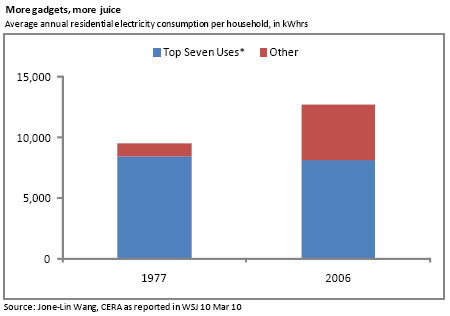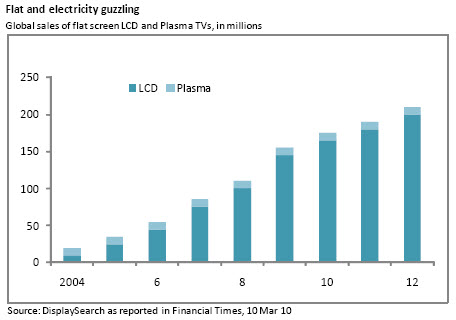This is a sample article from the April 2010 issue of EEnergy Informer.
Blame it on rapid proliferation of home entertainment devices
Setting aside the recent drop in electricity consumption, the first experienced in decades and entirely attributed to the current economic slump, demand for electricity in the US has been growing at a slow pace — not anywhere near the rates experienced in rapidly developing economies. The main drivers are growing population and continued proliferation of new electricity consuming devices.

In the all important residential sector, which accounts for roughly 40% of US electricity consumption, average consumption has risen even though the number of people per household continues to shrink. Americans are living in larger homes and migrating to the West and the South — which means higher air conditioning use. That much is easy to figure. But what may not be so obvious is the composition of consumption within a typical household.
When researchers began to decompose residential electricity consumption in mid 1970s, they identified 7 major uses for electricity within typical US households, namely air conditioners, space heating, water heating — these last two categories tend to be electric in warmer climates since they are less frequently needed — refrigerators, freezers, indoor lighting and ranges/ovens. In 1977, the average US household used 7,900 kWh with these 7 devices accounting for 91% of the total. Everything else added to a mere 9%.
The total has gradually grown over time — this is not surprising — but the proportion consumed by the 7 major categories has actually declined by 10% (see graph). The explanation? More efficient devices, better insulation and so on has more than offset the fact that homes tend to be bigger today requiring more cooling, more heating and more lighting. The average US home built today is roughly 50% larger than those built in mid 70s. The most stunning efficiency gains have come from refrigerators. The average fridge today uses a quarter of the energy used by its mid 1970 counterpart, even though they have grown significantly bigger and include more features.
While consumption by the 7 major categories has declined, overall consumption continues to rise due to the proliferation of a host of other electricity guzzling gadgets and devices that did not exist in the mid 1970s include flat-screen TVs and other audio/video home entertainment peripherals — by far the biggest electricity guzzling gadgets found in most US homes today — computers, printers, microwave ovens, dishwashers, outdoor lighting and a host of smallish gadgets that use little electricity individually, but add up collectively, such as portable phones, communication and entertainment devices.
According to Jone-Lin Wang, head of Global Power at Cambridge Energy Research Associates (CERA), the new devices outside the big-7 now account for 43% of average US household electricity use — and this proportion is expected to continue to grow. Alan Meier, an energy efficiency expert at Lawrence Berkeley National Laboratory (LBL) estimates that the average home in California has over 40 plugged devices today. Moreover, these devices collectively and continuously draw over 100 Watts of power, even when not in use, because of the stand-by features — the so-called phantom energy drain.
Nearly every Japanese home now has at least one flat screen TV, the percentage in US and Europe is close to 60% and rising. Consumer electronic makers are now eyeing a new generation of 3-dimensional TVs, the latest craze to hit the home entertainment market. The sales are projected to grow from 4.2 million this year to 78 million by 2015 according to iSuppli — a market research firm, and that is merely the tip of the iceberg.

Many up-scale US homes now feature a family entertainment room with high-end speakers, giant flat screen TV and assortment of peripherals to download, record, store and display audio and video, increasingly downloaded via the Internet. Who needs to go to the movies in this day and age? Likewise, a growing number of people in rich countries now work out of their home, which means personal computers, display screens, printers, scanners and a host of communication devices. Who needs to commute to the office — if only the boss will let you?
These trends have significant implications for future energy efficiency policies. Just when regulators and policy makers thought they were making headway in curbing residential electricity consumption, they find that a myriad of new devices with virtually no energy efficiency standards are penetrating the household sector at fast clip. This explains the recent decision by California Regulators, always on the leading edge, to set new energy efficiency standards for flat screen TVs.
Experts like LBL’s Mr. Meier are now pushing for standards and regulations to reduce phantom energy consumption, an insidious new threat because people are not even aware of its existence. To appreciate what is going on, turn “off” everything in the house and go watch the electric meter spin.

